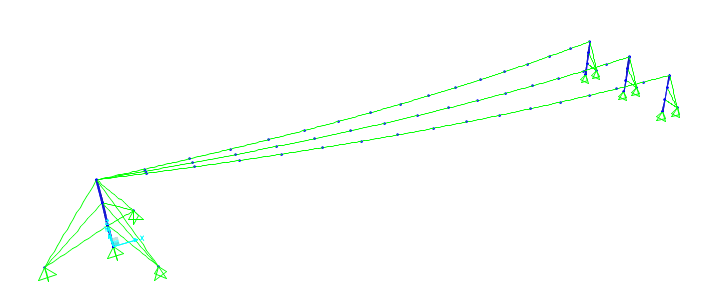Navigation
Install the app
How to install the app on iOS
Follow along with the video below to see how to install our site as a web app on your home screen.
Note: This feature may not be available in some browsers.
More options
Style variation
-
Congratulations MintJulep on being selected by the Eng-Tips community for having the most helpful posts in the forums last week. Way to Go!
You are using an out of date browser. It may not display this or other websites correctly.
You should upgrade or use an alternative browser.
You should upgrade or use an alternative browser.
Structural Design of Cable and Steel Posts Holding the Cables
- Thread starter M.IDR
- Start date
- Status
- Not open for further replies.
BridgeSmith
Structural
As long as there aren't any loads on the span, and the wind doesn't blow, the 4 kips tension at 5.8' of sag is fairly close to what I got.
Rod Smith, P.E., The artist formerly known as HotRod10
Rod Smith, P.E., The artist formerly known as HotRod10
Lomarandil
Structural
I agree with BA, only the top guy cable is doing any good on the low posts.
For the taller post with guys at 120* intervals around, the layered guys make sense.
----
just call me Lo.
For the taller post with guys at 120* intervals around, the layered guys make sense.
----
just call me Lo.
- Thread starter
- #23
Dear, BridgeSmith
@dauwerda really appreciated your help. I will check my FEM model with it.
The Multiple cables are to stabilize the Steel Post as buckling is an issue right?
Should I go with this results, means my design is adequate to be constructed by using cables suspended between steel posts, is it a reliable design?
projected area is just these elements shown in the picture.(just these cables and the steel posts), These results were just due to self weight.BridgeSmith (Structural) What is the vertical sag relative to a straight line between the supports? Is the 600 lb load still applied? If the 600lb load is applied, what's the projected area for wind?
@dauwerda really appreciated your help. I will check my FEM model with it.
[/quote]dauwerda (Structural) Based on the image posted said:https://www.powerlinesystems.com/plscaddultralite)[/URL]
The Multiple cables are to stabilize the Steel Post as buckling is an issue right?
BAretired (Structural) What is the reason for using three ties on each post? Why not just one at the top?]
Should I go with this results, means my design is adequate to be constructed by using cables suspended between steel posts, is it a reliable design?
BridgeSmith
Structural
Should I go with this results, means my design is adequate to be constructed by using cables suspended between steel posts, is it a reliable design?
With just the selfweight applied, it may be working (I still can't tell, comparing to my spreadsheet), but we're still a few steps away from the point where we can say the model works under additional dead loads and wind loading. The wind loading, in particular, adds a whole layer of complexity to the analysis, because the forces are horizontal, and the deflection of the cable is no longer vertical, but at an angle between vertical and horizontal, so there's some vector addition to the applied loads.
Rod Smith, P.E., The artist formerly known as HotRod10
Wazir said:Should I go with this results, means my design is adequate to be constructed by using cables suspended between steel posts, is it a reliable design?
Your presentation to date has been very confusing. In your first post, you indicate one high post and three sub posts, each with a cable attached to the high post. In your next post, you show a tangent force of 5k "to hold the cable and specified sag is achieved", a span of 400' and a concentrated load of 600# at about the quarter point nearest the sub-posts. But you did not specify a sag.
Later on, you specify 4k tension, elevation difference of 13.5' and a 2.5' sag measured from the top of the sub-posts.
Your design has not been demonstrated to be reliable, and it does not appear to satisfy statics.
BA
Wazir_Malang:
If you don’t understand what BA is trying to tell you, you probably shouldn’t be doing the engineering on this problem. I don’t care what software you are using, why you don’t know how to model your problem, or understand the output, or why you can’t approximately check the results with some long hand calcs., and simple statics, etc. You really don’t seem qualified to be doing this engineering work. You shouldn’t be asking the questions you are, the way you are, and then expect this to be built with some degree of confidence. You can’t even describe your problem with enough engineering detail and specificity so the real engineers can understand what you are trying to do. And, when this appears to be the case, we don’t have much confidence in your hidden assumptions, modeling or untold requirements. Talk with your boss about this problem, so he/she knows what you know and what you don’t know, so they can guide you, and keep you and your company out of trouble. I can imagine that more than one tie-back is needed at the posts. The lower ones are for lateral stability of the entire system, at the posts, but you haven’t spelled this out either.
If you don’t understand what BA is trying to tell you, you probably shouldn’t be doing the engineering on this problem. I don’t care what software you are using, why you don’t know how to model your problem, or understand the output, or why you can’t approximately check the results with some long hand calcs., and simple statics, etc. You really don’t seem qualified to be doing this engineering work. You shouldn’t be asking the questions you are, the way you are, and then expect this to be built with some degree of confidence. You can’t even describe your problem with enough engineering detail and specificity so the real engineers can understand what you are trying to do. And, when this appears to be the case, we don’t have much confidence in your hidden assumptions, modeling or untold requirements. Talk with your boss about this problem, so he/she knows what you know and what you don’t know, so they can guide you, and keep you and your company out of trouble. I can imagine that more than one tie-back is needed at the posts. The lower ones are for lateral stability of the entire system, at the posts, but you haven’t spelled this out either.
I find that in most structural applications of cables, the sag is small enough that catenary theory can be ignored with reasonable accuracy. The actual cable length is close enough to the horizontal length so that the error will be minor.
In keeping with dhengr's post, simple statics are preferred. The diagram below illustrates a simple method which I suggest using. I am considering a single post at A and B differing in top elevation by 13.5'. I am assuming a weight of 1.5 #/' for the cable, based on an area of 0.44 in2 given earlier by the OP. That should be checked as it seems a bit high, since that is the area of a 3/4" dia. solid bar. However, it does not consider the possibility of wind or ice forces as mentioned by others. And it does not consider the concentrated load of 600# as shown on one of the OP sketches, but that would be easily handled in the same manner. If the high post supports more than one cable, the reactions will be different.
I have not attempted to draw the cable profile, but the low point of cable is below point C. I found the low point to be 2.27' below point B, which would be about 6' below point C.
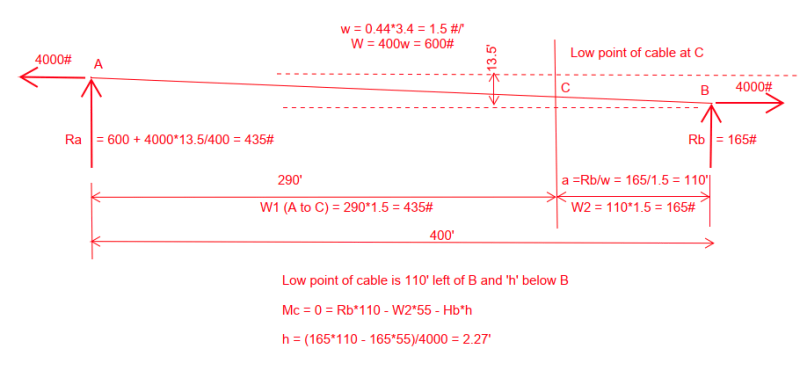
BA
In keeping with dhengr's post, simple statics are preferred. The diagram below illustrates a simple method which I suggest using. I am considering a single post at A and B differing in top elevation by 13.5'. I am assuming a weight of 1.5 #/' for the cable, based on an area of 0.44 in2 given earlier by the OP. That should be checked as it seems a bit high, since that is the area of a 3/4" dia. solid bar. However, it does not consider the possibility of wind or ice forces as mentioned by others. And it does not consider the concentrated load of 600# as shown on one of the OP sketches, but that would be easily handled in the same manner. If the high post supports more than one cable, the reactions will be different.
I have not attempted to draw the cable profile, but the low point of cable is below point C. I found the low point to be 2.27' below point B, which would be about 6' below point C.

BA
BridgeSmith
Structural
BAretired, your "simple statics" approach may give results that approximate other analysis methods, but in order to satisfy the statics of the distributed weight of the wire, the vertical reactions at the ends of the span would have to be nearly equal, varying only slightly with the amount of the sag, approaching exactly equal as the sag decreases.
At zero sag, the tension also becomes infinitely large.
The low point also changes significantly with the amount of sag, from nearly midspan for high sag values, to actually being at the right end of the span for low sag values.
Rod Smith, P.E., The artist formerly known as HotRod10
At zero sag, the tension also becomes infinitely large.
The low point also changes significantly with the amount of sag, from nearly midspan for high sag values, to actually being at the right end of the span for low sag values.
Rod Smith, P.E., The artist formerly known as HotRod10
BridgeSmith said:BAretired[/color]]BAretired, your "simple statics" approach may give results that approximate other analysis methods, but in order to satisfy the statics of the distributed weight of the wire, the vertical reactions at the ends of the span would have to be nearly equal, varying only slightly with the amount of the sag, approaching exactly equal as the sag decreases.
When the supports are at an equal elevation, the vertical reactions would have to be nearly equal, but when Point B is 13.5' lower than Point A, they must differ by 2*13.5H/L where, in this case, H is 4000# And L is 400 feet (statics).
At zero sag, the tension also becomes infinitely large.
I agree, and that condition is impossible.
The low point also changes significantly with the amount of sag, from nearly midspan for high sag values, to actually being at the right end of the span for low sag values.
The low point of the cable changes in elevation,but not in the position in the span. So if a tension of 5000# is specified, the sag below point B becomes 1.82' but the low point of cable remains directly below Point C.
EDIT:
Oops, typing before thinking, a bad habit. If H = 5000#, the reaction at Point B becomes 300 - 5000*13.5/400 = 131.25#, so the low point moves to 131.25/1.5 = 87.5' from Point B. And the elevation changes as well.
If H is large enough to remove the vertical reaction at Point B, the low point of the cable is at Point B and The vertical reaction at Point A is the total weight of the cable, i.e. 600#. That would occur when 13.5H/L = W/2. In this case, when H = 8889#.
I have modified my sketch to show the sag of the cable (area shaded green).
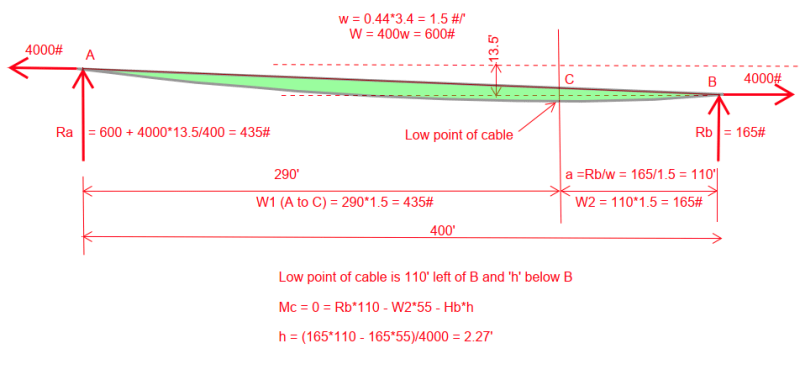
BA
Wazir Malang,
Correct me if I'm wrong, but this project is located in Pakistan and cannot have freezing conditions, so icing of the cables is not likely to be a factor.
The same is not true for wind. You must consider lateral forces due to wind in combination with the cable weight and any additional concentrated loads which may be suspended from the cables.
I don't agree with your arrangement of bracing for the vertical posts. If you wish, this could be discussed further.
Just as a matter of curiosity, what is the purpose of this cable assembly?
The view below is of the Grand Tower pipeline suspension bridge crossing the Missouri River. The main cables directly above the pipe have a substantial drape in order to carry the weight of a heavy pipe filled with natural gas. The pipe is suspended by vertical cables attached to the main cables, not easily seen in the photo. Wind forces are resisted by a cable on each aide attached to rigid arms projecting out from the vertical posts.
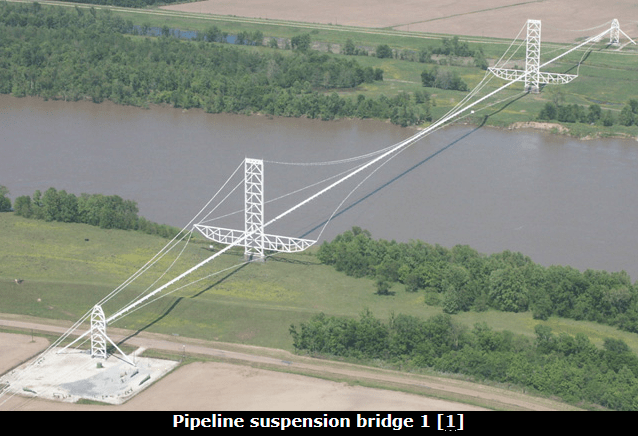
See details on: BA
Correct me if I'm wrong, but this project is located in Pakistan and cannot have freezing conditions, so icing of the cables is not likely to be a factor.
The same is not true for wind. You must consider lateral forces due to wind in combination with the cable weight and any additional concentrated loads which may be suspended from the cables.
I don't agree with your arrangement of bracing for the vertical posts. If you wish, this could be discussed further.
Just as a matter of curiosity, what is the purpose of this cable assembly?
The view below is of the Grand Tower pipeline suspension bridge crossing the Missouri River. The main cables directly above the pipe have a substantial drape in order to carry the weight of a heavy pipe filled with natural gas. The pipe is suspended by vertical cables attached to the main cables, not easily seen in the photo. Wind forces are resisted by a cable on each aide attached to rigid arms projecting out from the vertical posts.

See details on: BA
BridgeSmith
Structural
When the supports are at an equal elevation, the vertical reactions would have to be nearly equal, but when Point B is 13.5' lower than Point A, they must differ by 2*13.5H/L where, in this case, H is 4000# And L is 400 feet (statics).
I had to think about this for awhile, but eventually, I came to the conclusion that you're right about this. The angle of the cable to a chord line between the attachment points is equal at both ends, but in this case, when the chord line is not level, the tension force in the wire (and the reaction) have a different angle to the pole at each end. The conclusions are slightly incorrect in that respect. The tension in the wire is not equal to the horizontal reactions. The tension is the vector sum of the horizontal and vertical reactions at each end. The tension is at it's maximum at the left end of the span, although unless the sag is excessive, the tension changes very little across the span.
For your sketch, the tension at the left end would be sqrt(4352 + 40002) = 4023.6 lbs (4003.4 lbs at the right end). The tension in the cable is 4000 lbs at the lowest point of the sag. Also, the horizontal component of the force in the cable is 4000 lbs at any point along the cable.
The tension changes as the angle changes, so the angle of the wire for each segment along the span can be calculated, and the length of the cable in the segment can be approximated. We use those calculations to analyze spans with flexible supports (poles without guy wires), by calculating the deflection of the poles and iterating until the deflection under additional load (such as wind) matches the 'apparent' change in the cable length, due to the additional deflection (horizontal 'sag').
Speaking of guy wires, don't neglect to check the tension in the guy wires; it will be significantly greater than the tension in the span wire. There is also the vertical component of the tension in the guy wire that produces axial compression in the pole. The buckling capacity of the discreetly braced pole and the bearing capacity of the foundation will need to be considered.
Rod Smith, P.E., The artist formerly known as HotRod10
Lomarandil
Structural
I believe many parts of northern Pakistan are in fact subject to freezing conditions.
----
just call me Lo.
----
just call me Lo.
- Thread starter
- #35
The Actual purpose of this posts are for training as shown in the picture. But only single person will use at time on a single cable. sample picture shows.
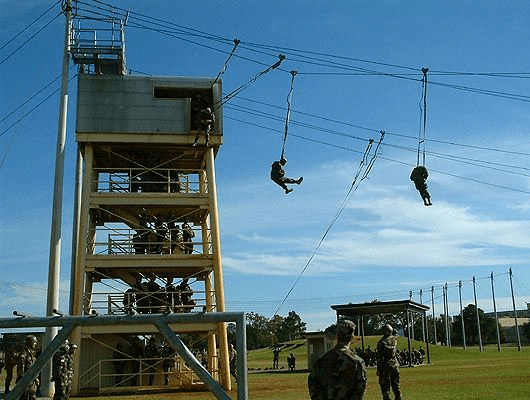
No ice loading is possible.
Do you think that wind loading consideration would be required in the analysis?

No ice loading is possible.
Do you think that wind loading consideration would be required in the analysis?
- Thread starter
- #36
Here are the complete results to clear your Concern Dear @BAretired and @BridgeSmith
You are right that the reaction at the left support should be the same as the forces coming from the Main cables but as you know these pair of cable does not just resist the main Cables but also the balancing cables in which i have shown. The reaction is not just from the main cables suspended between the Main Post and SUB Posts but also from the balancing cables that are used to stabilize the MAIN POST which are two in number rotated at 120degrees as shown. Now I have showed Manual calcs as @dhengr was referring to inspite of helping he was criticizing, which you can see that My FEM seems to be OK. I will look forward to your response.
@BAretired yes it is in PAKISTAN and ICE is not a problem, Where can you confirm if wind would cause any significant effect as the projected area for wind is very small @BridgeSmith.?
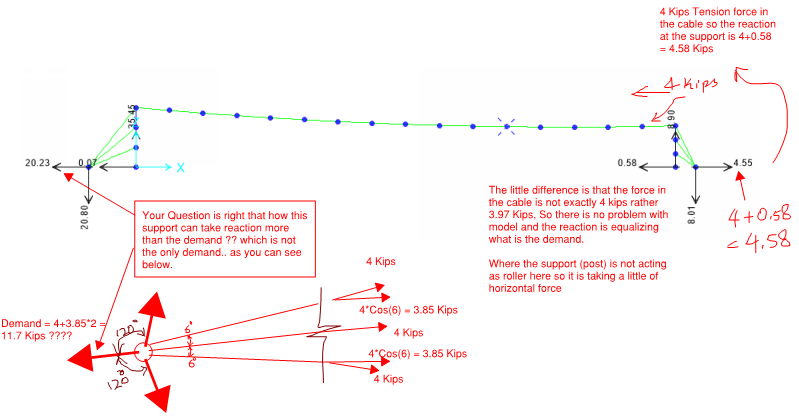
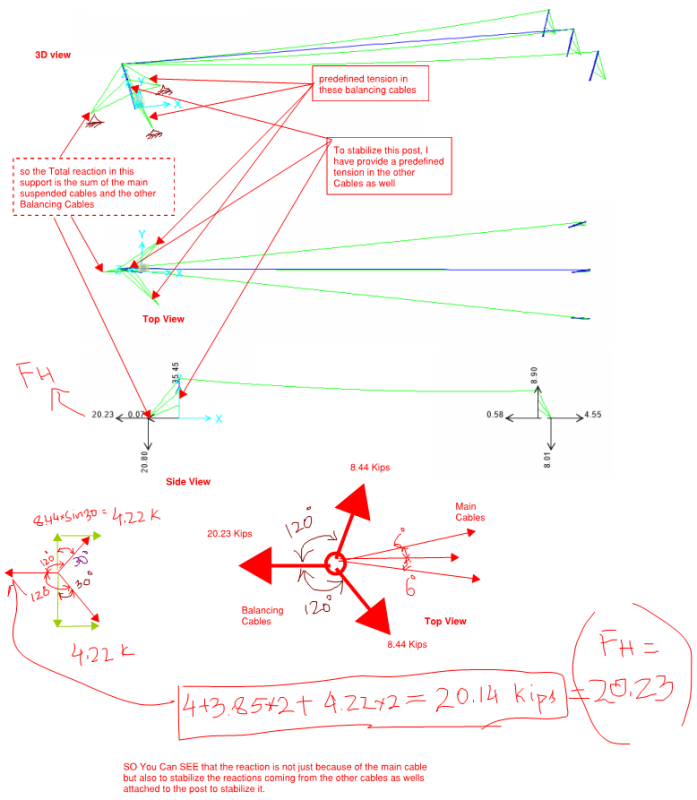
You are right that the reaction at the left support should be the same as the forces coming from the Main cables but as you know these pair of cable does not just resist the main Cables but also the balancing cables in which i have shown. The reaction is not just from the main cables suspended between the Main Post and SUB Posts but also from the balancing cables that are used to stabilize the MAIN POST which are two in number rotated at 120degrees as shown. Now I have showed Manual calcs as @dhengr was referring to inspite of helping he was criticizing, which you can see that My FEM seems to be OK. I will look forward to your response.
@BAretired yes it is in PAKISTAN and ICE is not a problem, Where can you confirm if wind would cause any significant effect as the projected area for wind is very small @BridgeSmith.?


"""WazirMalangSEBridgeSmith
Structural
Where can you confirm if wind would cause any significant effect as the projected area for wind is very small @BridgeSmith.?
By my analysis, a 90mph wind on a single 3/4" cable produces a greater load (8300 lbs) than a 300lb point load at midspan (8100 lbs). It appear you have a pair of 3/4" cables going to each tower to the right, for a total of 6 cables to the tower on the left. That's a horizontal load of almost 50 kips at the left tower, and tension on the anchor cable of around 70 kips (assuming a 45 degree angle of the anchor cable). It's also about 50 kips of axial compression on the tower pole and more than 50 kips of bearing capacity required for the pole foundation.
Rod Smith, P.E., The artist formerly known as HotRod10
- Thread starter
- #38
- Thread starter
- #39
@BridgeSmith Do you think wind load should be applied based on the projected area of the elements in any direction?
I have applied 30 lb/ft wind loads on the posts but my FEM software does not apply wind load to cables do you think that is necessary as well?
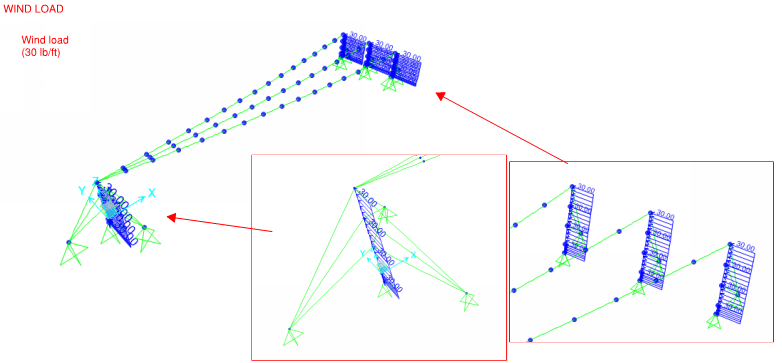
When I apply 1000 lbs of point load then the axial compression is about 51.6 kips for which the left post is designed but anchor block is designed for 40 Kips
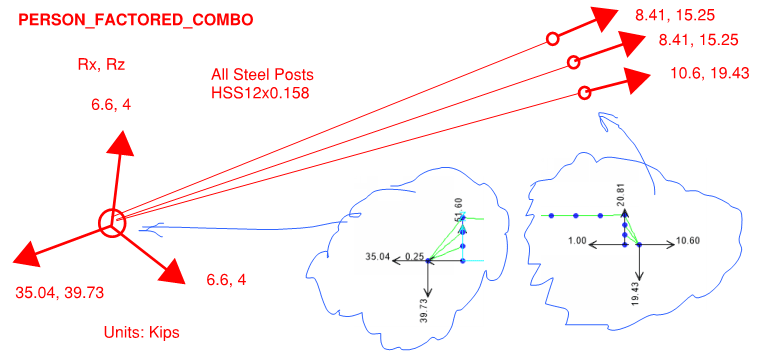
I have applied 30 lb/ft wind loads on the posts but my FEM software does not apply wind load to cables do you think that is necessary as well?

When I apply 1000 lbs of point load then the axial compression is about 51.6 kips for which the left post is designed but anchor block is designed for 40 Kips

That structure is called a Zip Line, or in this case, a triple Zip Line.
I attempted to measure the maximum angle from the photograph (see below). The thick red line is my estimate of the slope of an unloaded cable at the left support. It isn't very accurate, but it looks like about 18o for a cable without a person suspended from it. The maximum angle we calculated earlier in the post, using a horizontal component of 4000# and a vertical component of 435# was tan-1(435/4000) = 6.2o. I have no experience with zip line design, but I wonder if the angle proposed is a bit shallow. It may be prudent to find the recommended slope from zip line manufacturers.
Insofar as wind design, the structure should be capable of resisting expected maximum wind loads when unloaded, but it seems unlikely it would be loaded with personnel during a 90 mph wind.
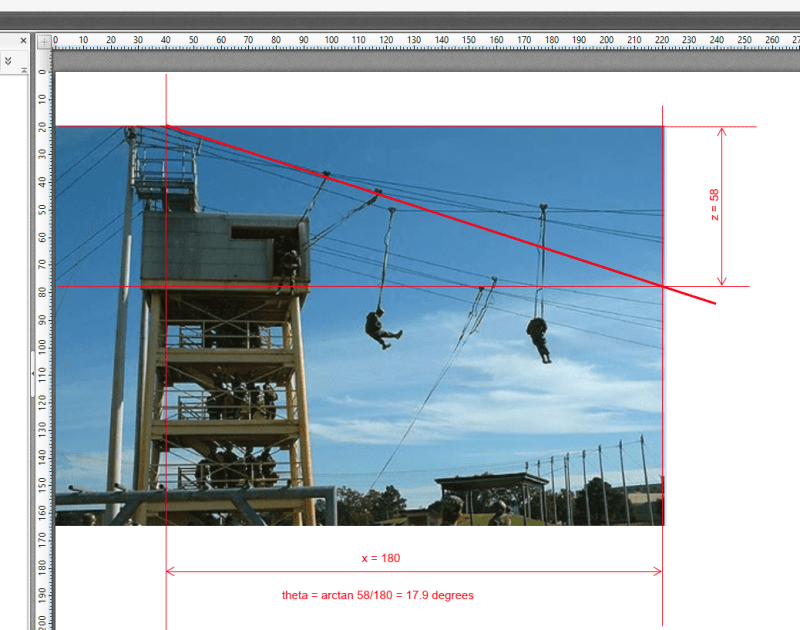
Note: the man on the left seems to be deflecting his cable considerably more than the guy on the right. This suggests to me that the cables on the installation are not equally tightened.
BA
I attempted to measure the maximum angle from the photograph (see below). The thick red line is my estimate of the slope of an unloaded cable at the left support. It isn't very accurate, but it looks like about 18o for a cable without a person suspended from it. The maximum angle we calculated earlier in the post, using a horizontal component of 4000# and a vertical component of 435# was tan-1(435/4000) = 6.2o. I have no experience with zip line design, but I wonder if the angle proposed is a bit shallow. It may be prudent to find the recommended slope from zip line manufacturers.
Insofar as wind design, the structure should be capable of resisting expected maximum wind loads when unloaded, but it seems unlikely it would be loaded with personnel during a 90 mph wind.

Note: the man on the left seems to be deflecting his cable considerably more than the guy on the right. This suggests to me that the cables on the installation are not equally tightened.
BA
- Status
- Not open for further replies.
Similar threads
- Question
- Replies
- 7
- Views
- 13K
- Question
- Replies
- 0
- Views
- 6K
- Question
- Replies
- 8
- Views
- 1K
- Replies
- 5
- Views
- 2K


